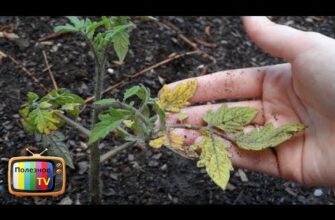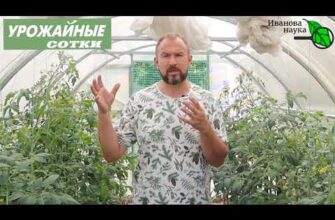- Почему верхушка стебля томатов желтеет
- Недостаток полива
- Недостаток питательных веществ
- Вредные факторы, способствующие появлению желтой верхушки стебля
- Недостаток питательных веществ
- Неоптимальная влажность почвы
- Неправильный режим полива
- Повреждения корней
- Негативное воздействие низких температур
- Как бороться с желтеющей верхушкой стебля томатов
- 1. Проверьте питательность почвы
- 2. Обеспечьте регулярный полив
- Вариант 1: Правильное удобрение и подкормка
- Вариант 2: Корректировка полива и влажности почвы
- Полезные советы по уходу за томатами
- 1. Почему верхушка стебля томатов желтеет?
- 2. Два простых способа борьбы с этой проблемой
- Вопрос-ответ:
- Почему у томатов желтеет верхушка стебля?
- Как исправить проблему желтения верхушки стебля у томатов?
- Можно ли предотвратить желтеение верхушки стебля у томатов?
- Что такое кальциевая гниль и как с ней бороться?
- Видео:
- ЖЕЛТЕЮТ ЛИСТЬЯ У ТОМАТОВ? ВСЁ ИСПРАВЛЯЕТСЯ В МОМЕНТ
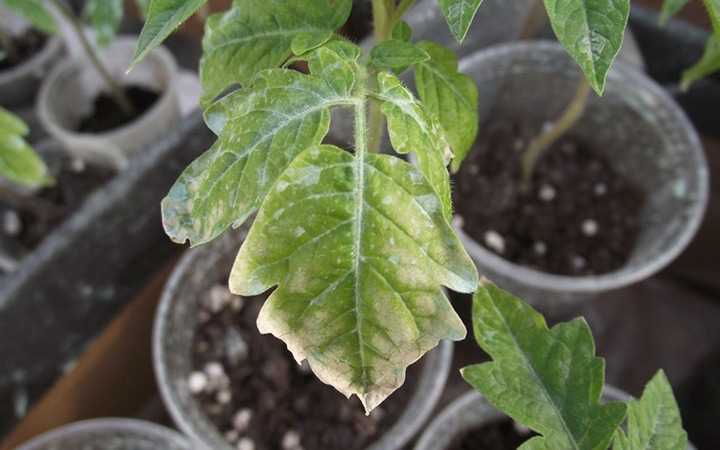
Верхушка стебля томатов желтеет – это распространенная проблема, с которой сталкиваются многие садоводы. Желтение верхушки стебля может быть вызвано несколькими факторами, такими как недостаток питательных веществ, неправильный полив или неблагоприятные условия роста. Однако, несмотря на многообразие причин, существуют простые способы борьбы с этой проблемой.
Один из наиболее распространенных способов предотвращения желтения верхушки стебля томатов – регулярное подкормка растений. Томатам необходимо постоянное пополнение запасов питательных веществ, чтобы они могли нормально расти и развиваться. Для этого можно использовать органические удобрения, такие как перегной или компост, а также специальные минеральные удобрения для томатов. Регулярное подкормка позволит предотвратить недостаток питательных веществ и улучшить общее состояние растений.
Второй способ борьбы с желтеющей верхушкой стебля томатов – правильный полив. Недостаток влаги может привести к стрессу для растений и, как следствие, к желтеющей верхушке стебля. Регулярный и умеренный полив поможет поддерживать оптимальную влажность почвы и предотвратить пересыхание корней. Оптимальное время для полива томатов – утро или вечер, когда температура наиболее комфортная для растений. Не забывайте также следить за дренажем почвы, чтобы избежать застоя воды, что может вызвать гниение корней.
Почему верхушка стебля томатов желтеет

Желтение верхушки стебля томатов может быть вызвано несколькими причинами, и важно понять, какой именно фактор приводит к этой проблеме.
Недостаток полива
Одной из возможных причин желтения верхушки стебля томатов является недостаток полива. Когда растение получает недостаточное количество влаги, оно начинает отделяться от верхушки, что приводит к ее желтению. Для борьбы с этой проблемой необходимо регулярно поливать томаты, особенно в периоды сухости.
Недостаток питательных веществ

Еще одной причиной желтения верхушки стебля томатов может быть недостаток питательных веществ. Если почва не содержит достаточного количества необходимых элементов питания, то растение не сможет нормально развиваться, что может привести к желтению верхушки стебля. Для решения этой проблемы необходимо удобрять почву регулярно, используя удобрения, богатые необходимыми элементами питания.
В заключение, желтеющая верхушка стебля томатов может быть вызвана недостатком полива или недостатком питательных веществ в почве. Чтобы бороться с этой проблемой, необходимо регулярно поливать растения и удобрять почву. Таким образом, можно поддерживать здоровый рост и развитие томатов.
Вредные факторы, способствующие появлению желтой верхушки стебля

Несоблюдение условий выращивания: одной из основных причин появления желтой верхушки стебля томатов является неправильное содержание растений. Томаты требуют определенных условий: достаточное количество света, оптимальную температуру и влажность воздуха, правильный режим полива и удобрения.
Нехватка влаги: дефицит влаги в почве может привести к появлению желтой верхушки стебля. Томаты нуждаются в регулярном поливе, особенно в жаркую погоду. Недостаток влаги может вызвать стресс у растения и привести к нарушению транспорта питательных веществ к верхушке стебля, что приводит к желтению.
Недостаток питательных веществ: некоторые макро- и микроэлементы необходимы для нормального развития растений. Недостаток питательных веществ, таких как азот, калий, магний, железо и др., может привести к появлению желтой верхушки стебля у томатов. Регулярное удобрение поможет предотвратить эту проблему.
Болезни и вредители: желтая верхушка стебля может быть результатом поражения растения болезнями или вредителями, такими как фитофтороз, вирусное поражение, клещи и другие. Это может привести к нарушению транспорта питательных веществ и вызвать желтение верхушки стебля. Регулярная проверка растений и применение необходимых мер борьбы помогут предотвратить эти проблемы.
Недостаток питательных веществ
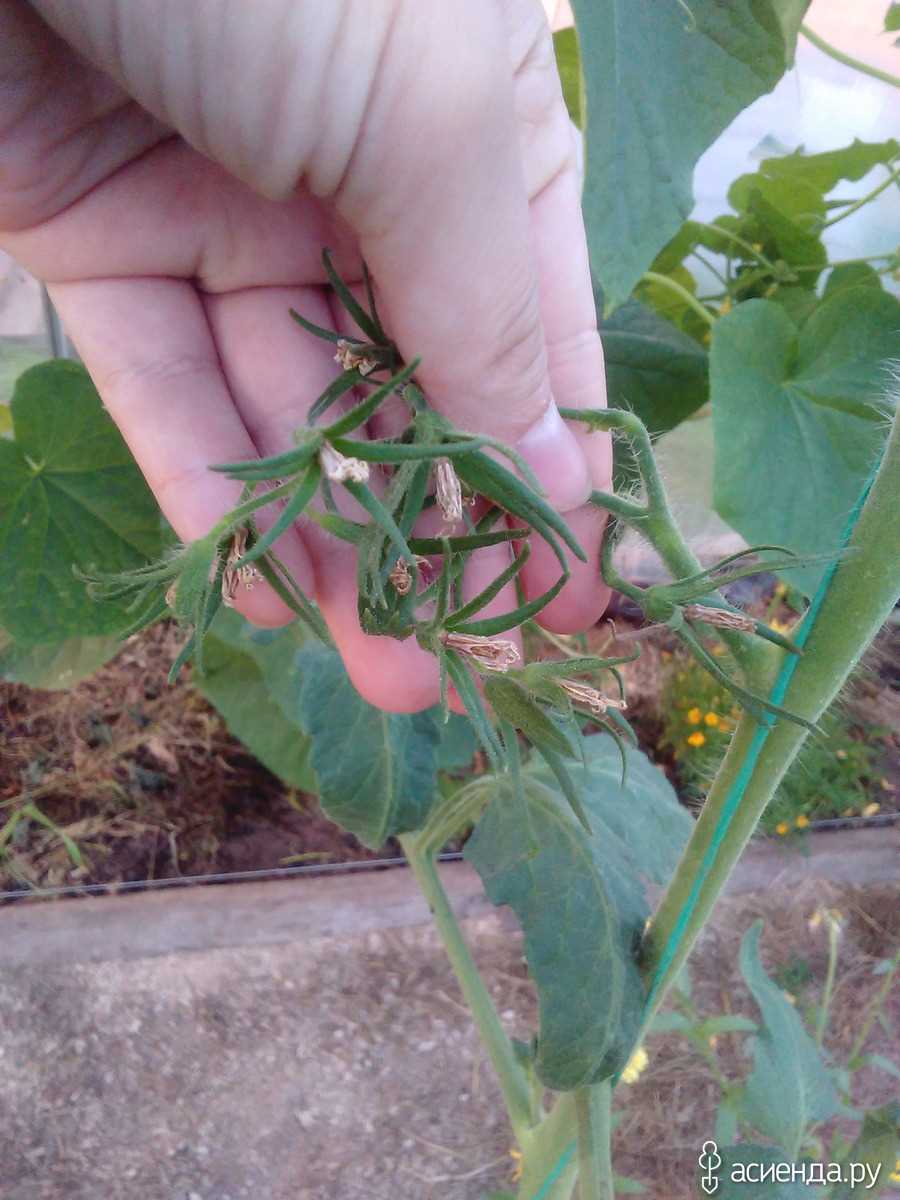
Один из возможных способов, почему у томатов желтеет верхушка стебля, может быть связан с недостатком питательных веществ. Томаты являются растениями, которые требуют определенного набора питательных веществ для нормального роста и развития. Если почва, в которой выращиваются томаты, не содержит достаточного количества данных веществ, то верхушка стебля может начать желтеть.
Для борьбы с этой проблемой существует два основных способа. Первый способ — внесение удобрений в почву. Удобрения содержат необходимые питательные вещества, которые могут помочь растениям восстановить нормальный баланс и предотвратить появление желтения верхушки стебля у томатов. Второй способ — коррекция полива. Недостаток питательных веществ может возникать из-за неправильного полива, когда растения получают либо слишком много, либо слишком мало воды. Правильное регулирование полива может помочь предотвратить желтение верхушки стебля у томатов.
Неоптимальная влажность почвы
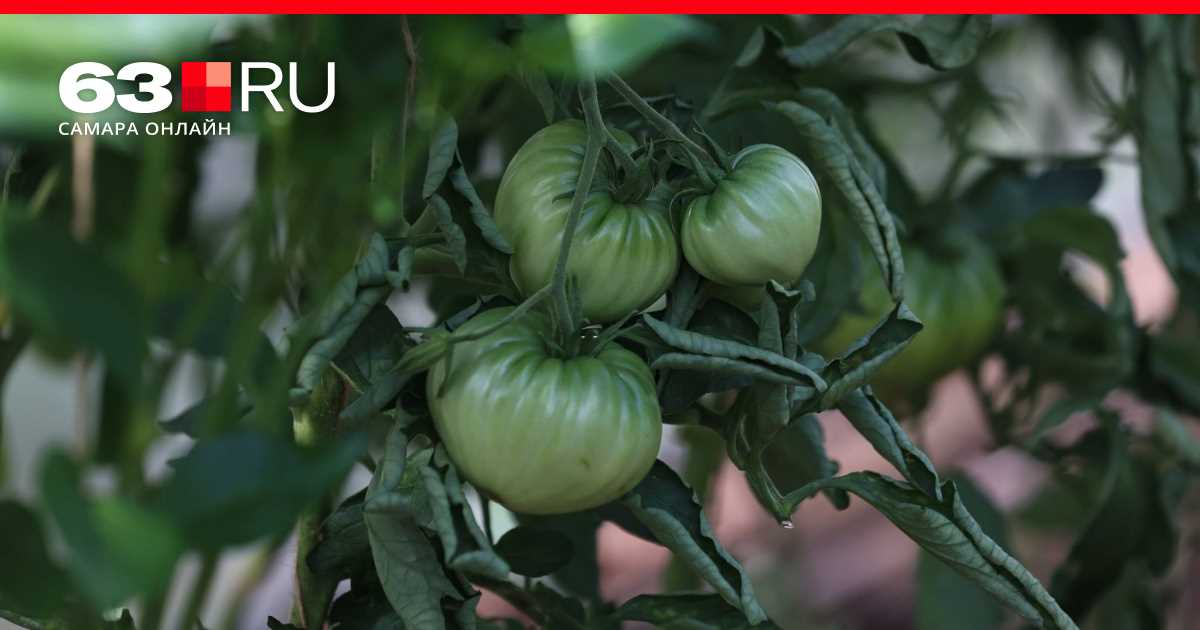
Одной из причин, почему у томатов желтеет верхушка стебля, может быть неоптимальная влажность почвы. Если почва слишком сухая или, наоборот, слишком влажная, то корни растения не могут получить необходимое количество воды и питательных веществ, что приводит к желтушности верхушки стебля.
Для борьбы с этой проблемой существуют два простых способа: контроль влажности почвы и правильное поливание.
Важно следить за уровнем влажности почвы и поддерживать его на оптимальном уровне. Для этого можно использовать специальные приборы для измерения влажности почвы или просто проверять ее регулярно, проводя пальцем небольшую проверку на глубине 2-3 см. Если почва сухая, то необходимо поливать растение, обеспечивая достаточное количество воды, но не переувлажнять, чтобы избежать гниения корней.
Также важно знать, что томаты любят регулярное поливание, но не переносят застой влаги. Поэтому следует поливать их умеренно, подкормливая растение удобрениями с низким содержанием азота, чтобы избежать излишнего роста зелени и сосредоточиться на формировании плодов.
Неправильный режим полива
Один из двух способов борьбы с проблемой желтеющей верхушки стебля томатов связан с неправильным режимом полива. Почему желтеет верхушка стебля томатов? Одной из возможных причин может быть недостаток или избыток влаги в почве.
Чтобы избежать желтизны верхушки стебля томатов, необходимо следить за оптимальным режимом полива. Во-первых, регулярно и достаточно поливайте растения, учитывая их потребности влаги. Для этого можно использовать различные методы полива: капельный, традиционный или систему автополива.
Во-вторых, обратите внимание на качество воды для полива. Часто причиной желтеющей верхушки стебля томатов является несоответствие кислотности или содержания минералов в воде требованиям растения. Постарайтесь использовать мягкую, фильтрованную или дождевую воду, которая не содержит излишнего количества хлора или других химических веществ.
Важно помнить, что переувлажнение или пересушивание почвы может стать причиной проблемы с желтеющей верхушкой стебля томатов. Постепенно настраивайте режим полива на оптимальный уровень, особенно в периоды активного роста и плодоношения растений. Наблюдайте за состоянием почвы, чтобы поддерживать необходимый уровень влажности.
Повреждения корней
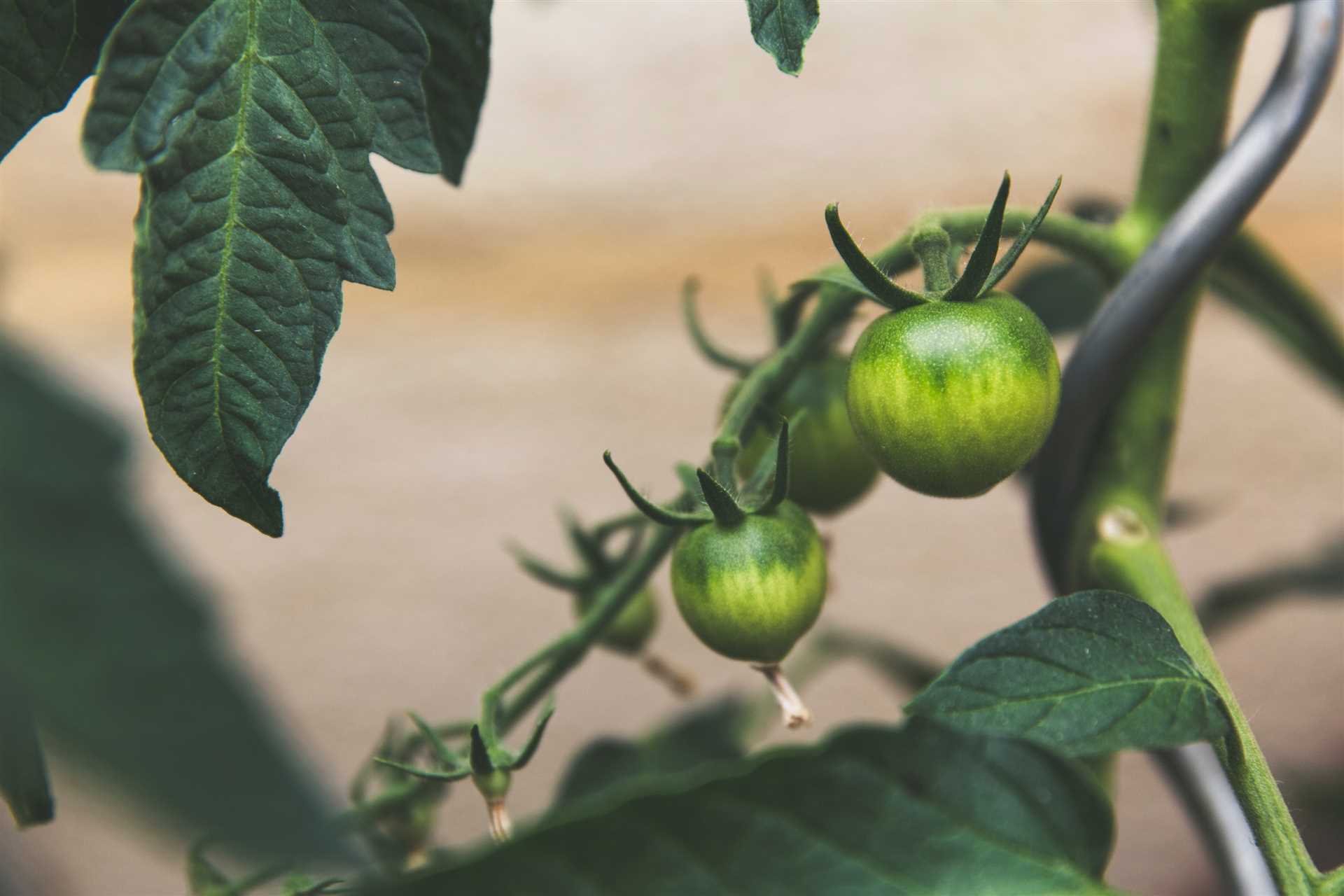
Одной из причин, почему верхушка стебля томатов желтеет, может быть повреждение корней растения. Корни томатов могут быть повреждены из-за неправильного полива или недостатка питательных веществ в почве. Если растение не получает достаточного количества влаги или питательных веществ, его корни начинают отмирать, что приводит к желтизне верхушки стебля.
Для борьбы с этой проблемой существуют два простых способа. Во-первых, необходимо обеспечить растению достаточное количество влаги. Полив томатов должен быть регулярным и достаточным, чтобы земля в горшке или грядке всегда была увлажненной. Важно помнить, что томаты любят умеренный полив и не переносят переувлажнение.
Так стоп!!! Вы всё ещё не подписаны на наши каналы в Телеграмм и Дзен? Посмотрите: ТГ - (@historyfantasydetectivechat) и Дзен (https://dzen.ru/myshortsstorys)
Во-вторых, необходимо обеспечить растению необходимые питательные вещества. Для этого можно использовать специальные удобрения для томатов, которые содержат все необходимые макро- и микроэлементы. Удобрения могут быть применены как в жидком, так и в гранулированном виде. Регулярное подкормка поможет растению избежать дефицита питательных веществ и сохранить здоровье корней.
Негативное воздействие низких температур
Одной из причин, почему у томатов желтеет верхушка стебля, может быть негативное воздействие низких температур. Томаты являются теплолюбивыми растениями, их оптимальная температура для роста и развития составляет около 20-25 градусов Цельсия.
При понижении температуры ниже 15 градусов Цельсия томаты начинают испытывать стресс, что может привести к желтению верхушки стебля. Низкие температуры замедляют обмен веществ в растении, что приводит к нарушению снабжения клеток питательными веществами и водой.
В борьбе с этой проблемой можно использовать два основных способа. Первый — поддерживать необходимую температуру в помещении, где растут томаты. Для этого можно использовать специальные обогреватели или теплицы.
Второй способ — предоставить томатам дополнительную поддержку в виде удобрений. Недостаток питательных веществ может усугубить проблему с желтеющей верхушкой стебля. Регулярное внесение удобрений, содержащих азот, фосфор и калий, поможет растениям справиться с негативным воздействием низких температур и сохранить здоровую зеленую верхушку стебля.
Как бороться с желтеющей верхушкой стебля томатов

Почему верхушка стебля томатов желтеет? Эта проблема является распространенной и может быть вызвана несколькими факторами. Одной из причин может быть недостаток питательных веществ в почве или неправильное удобрение. Вторым возможным объяснением является недостаток влаги, поскольку пересушенная почва может привести к желтению верхушек стеблей томатов.
1. Проверьте питательность почвы

Первым шагом в борьбе с желтеющей верхушкой стебля томатов является проверка питательности почвы. Для этого можно воспользоваться специальным тестом, который определит уровень основных питательных веществ, таких как азот, фосфор и калий. Если вы обнаружите недостаток какого-либо из этих элементов, можно применить соответствующее удобрение, чтобы восстановить равновесие и предотвратить желтеющую верхушку стебля.
2. Обеспечьте регулярный полив
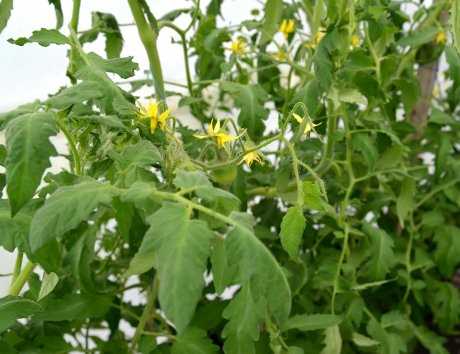
Вторым способом борьбы с желтеющей верхушкой стебля томатов является обеспечение регулярного полива. Томаты требуют достаточного количества влаги для нормального роста и развития. Пересушенная почва может привести к желтению верхушек стеблей, поэтому важно следить за уровнем влажности и поддерживать его на оптимальном уровне. Регулярный полив поможет избежать этой проблемы и обеспечить здоровый рост томатов.
Вариант 1: Правильное удобрение и подкормка
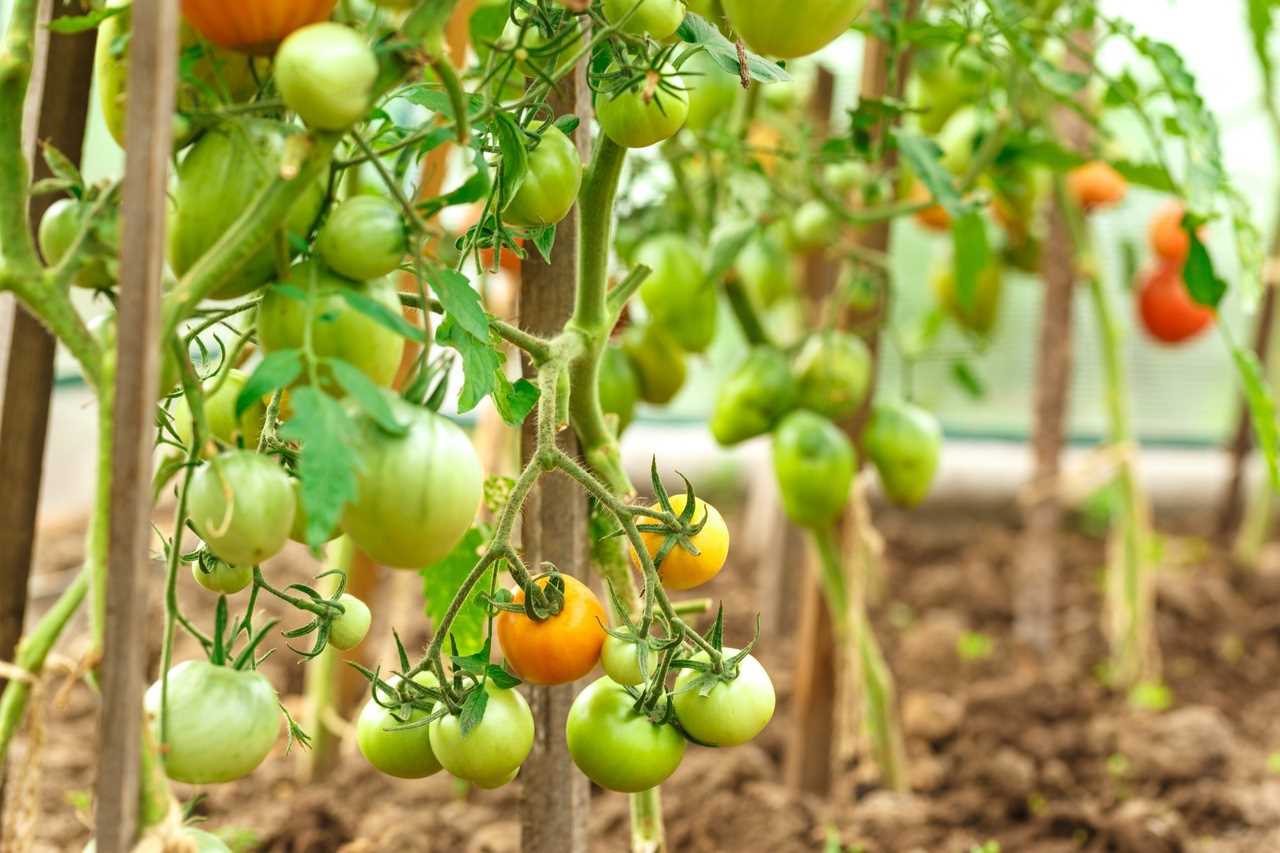
Одним из способов борьбы с проблемой, почему у томатов желтеет верхушка стебля, является правильное удобрение и подкормка. Ведь желтение верхушки стебля часто связано с недостатком определенных питательных веществ.
Первый шаг – определить, какие именно питательные вещества не хватает растениям. Для этого можно провести анализ почвы и узнать ее состав, а также обратить внимание на внешние признаки недостатка питательных веществ у томатов.
После определения недостающих питательных веществ следует выбрать подходящее удобрение. Для томатов особенно важны азот, фосфор и калий. Недостаток азота может привести к желтеющей верхушке стебля, поэтому рекомендуется использовать удобрения, богатые азотом.
Подкормка томатов также является важным шагом в борьбе с желтеющей верхушкой стебля. Рекомендуется проводить подкормку растений раз в 2-3 недели, начиная с момента появления первых завязей и до конца созревания плодов. Подкормка растений способствует улучшению их общего состояния и предотвращает желтеющую верхушку стебля.
Вариант 2: Корректировка полива и влажности почвы
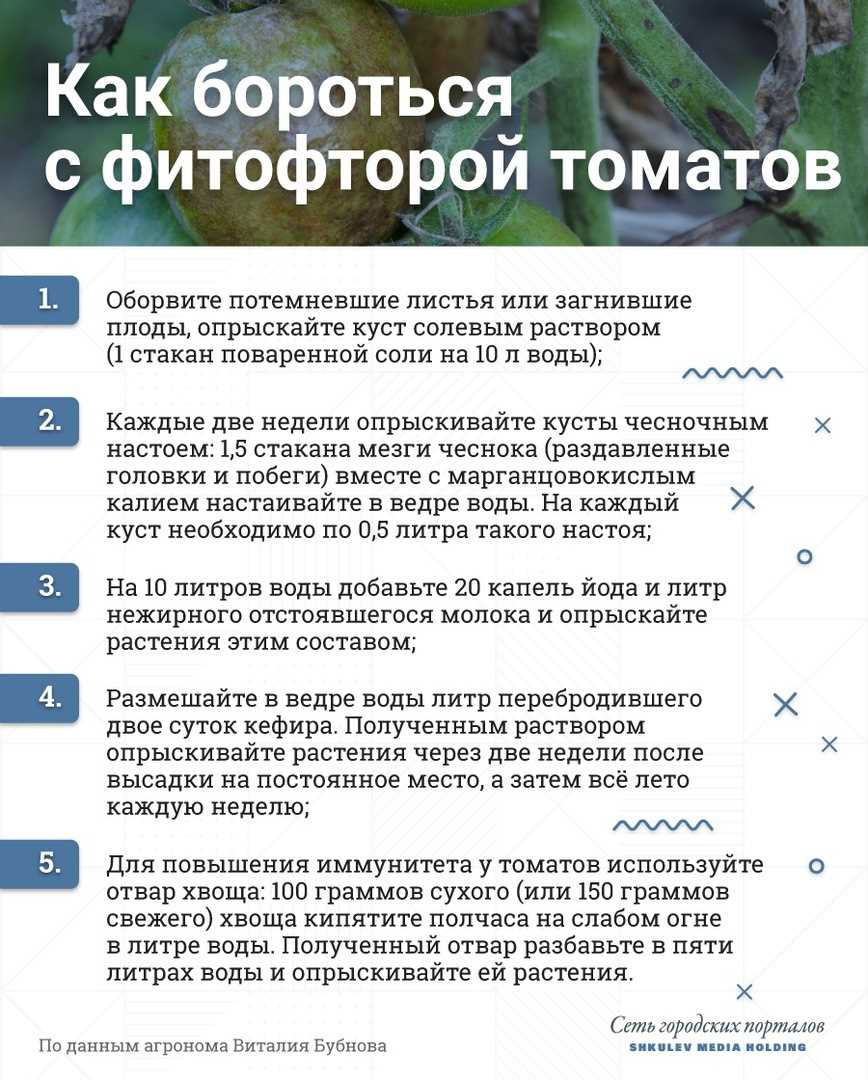
Одним из способов борьбы с проблемой желтения верхушки стебля у томатов является корректировка полива и влажности почвы. Почему желтеет верхушка стебля томата? Одной из причин может быть неправильный режим полива. Если почва слишком сухая или, наоборот, слишком мокрая, это может привести к желтению верхушки стебля и другим проблемам.
Для предотвращения желтения верхушки стебля томатов необходимо правильно настраивать полив. Регулируйте интенсивность полива и частоту полива в зависимости от погодных условий и состояния почвы. Если почва сухая, увеличьте интенсивность полива. Если почва мокрая, уменьшите интенсивность полива или вовсе прекратите полив на некоторое время.
Наблюдайте за состоянием почвы и растений:
- Осуществляйте регулярный контроль влажности почвы с помощью влагомера или простым способом — пальцем.
- Следите за состоянием листьев и стеблей: если они слишком желтеют или увядают, возможно, необходимо подкорректировать режим полива.
- Обратите внимание на погодные условия: в сухую погоду увеличьте интенсивность полива, а во время дождей или влажной погоды — сократите полив.
Контроль полива и влажности почвы поможет избежать проблемы желтения верхушки стебля у томатов и сделать растения более здоровыми и устойчивыми.
Полезные советы по уходу за томатами

1. Почему верхушка стебля томатов желтеет?

Одной из проблем, с которой часто сталкиваются садоводы при выращивании томатов, является желтение верхушки стебля. Это может быть вызвано несколькими факторами, такими как недостаток влаги, переувлажнение почвы, недостаток питательных веществ или переизбыток некоторых элементов.
2. Два простых способа борьбы с этой проблемой
Чтобы предотвратить желтеение верхушки стебля томатов, важно обеспечить растения правильным уходом. Во-первых, следите за регулярным поливом и поддерживайте влажность почвы на оптимальном уровне. Во-вторых, удобряйте растения специальными удобрениями для томатов, которые содержат все необходимые питательные вещества.
Для более эффективной борьбы с желтеющей верхушкой стебля томатов, можно также применить следующие методы:
- Регулярно проверяйте почву на наличие необходимых питательных веществ и проводите подкормки при необходимости.
- Обеспечьте рассеянное освещение для растений, чтобы предотвратить перегревание и ожоги на листьях.
- Постепенно привыкайте растения к солнечному свету, особенно если они были выращены в защищенном открытом грунте.
- Удалите поврежденные листья и стебли, чтобы предотвратить распространение возможных инфекций.
- Следите за температурным режимом и оберегайте растения от резких перепадов температур.
Вопрос-ответ:
Почему у томатов желтеет верхушка стебля?
Желтение верхушки стебля у томатов обычно связано с нехваткой кальция в почве. Это может быть вызвано неправильным уровнем pH почвы или недостаточным поступлением кальция из-за неправильного полива или дефицита в почве. Также желтение верхушек стеблей может быть связано с перегревом, недостатком влаги или поливом холодной водой.
Как исправить проблему желтения верхушки стебля у томатов?
Существует несколько способов исправить проблему желтения верхушки стебля у томатов. Во-первых, стоит проверить уровень pH почвы и при необходимости скорректировать его добавлением извести или серы. Кроме того, можно обеспечить правильное питание растения, добавив в почву удобрения, богатые кальцием. Также важно поддерживать оптимальный уровень влажности почвы и поливать томаты теплой водой.
Можно ли предотвратить желтеение верхушки стебля у томатов?
Да, можно предотвратить желтеение верхушки стебля у томатов, особенно если проблема уже возникала ранее. Для этого следует обеспечить растению достаточное количество кальция, поддерживать оптимальный уровень влажности почвы, правильно поливать томаты, избегая использования холодной воды, и регулярно проверять и корректировать уровень pH почвы.
Что такое кальциевая гниль и как с ней бороться?
Кальциевая гниль — это заболевание растений, которое проявляется в виде темно-коричневых пятен на плодах томатов. Это может быть вызвано недостатком кальция в почве или неправильным усвоением растения этого элемента. Для борьбы с кальциевой гнилью рекомендуется поддерживать стабильный уровень влажности почвы, не допускать пересыхания или переувлажнения, а также обеспечить растению достаточное количество кальция через удобрения или добавки в почву.


